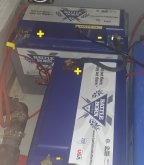With Will’s guidance I installed the following in my overland truck:
Having had this happen repeatedly, I sent #2 battery back to Battle Born. They said there was a problem with the BMS … fixed it and sent it back to me. I hooked everything back up …. Fully charged the bank and rechecked all MPPT settings. Needless to say I hoped I would actually get closer to a full discharge of 100ah from the two batteries.
Over the weekend while camping off grid …. It did the same thing again. When I went to bed, the Victron said we had expended 46 AH and we should have 40% more capacity. In the middle of the night with just a 3 amp draw from the refrigerator …. The system shut down .... just as it has in the past.
At this point all that I can think to do is return both batteries to BB and let them try and figure out why the two batteries are not discharging evenly. Before I take that action … I am wondered if the smart people on this forum could tell me if there is something I have done that is precluding these two from discharging evenly.
After spending close to $2K on these … I would really like to get the last 30% or so of their capacity.
Thanks!
- 700 watts of solar
- Connected to EPEVER MPPT 40A 150v
- Charging (2) 100ah 12v Battle Born(BB) connected in series
- Monitored by Victron BMV-712
Having had this happen repeatedly, I sent #2 battery back to Battle Born. They said there was a problem with the BMS … fixed it and sent it back to me. I hooked everything back up …. Fully charged the bank and rechecked all MPPT settings. Needless to say I hoped I would actually get closer to a full discharge of 100ah from the two batteries.
Over the weekend while camping off grid …. It did the same thing again. When I went to bed, the Victron said we had expended 46 AH and we should have 40% more capacity. In the middle of the night with just a 3 amp draw from the refrigerator …. The system shut down .... just as it has in the past.
At this point all that I can think to do is return both batteries to BB and let them try and figure out why the two batteries are not discharging evenly. Before I take that action … I am wondered if the smart people on this forum could tell me if there is something I have done that is precluding these two from discharging evenly.
After spending close to $2K on these … I would really like to get the last 30% or so of their capacity.
Thanks!






